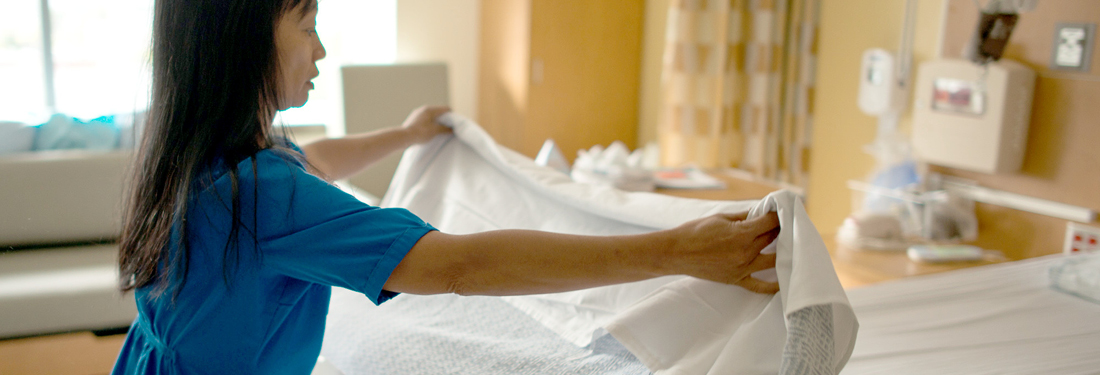Nursing Team Extends Care at the Bedside
Problem
Virginia Mason hospital nurses were increasingly leaving the patient’s bedside to complete non-value-added tasks, adding hours to their day, increasing stress and contributing to burnout. Studies show that the impacts of such interruptions and stress result in a greater risk of medical errors.
Opportunity
Virginia Mason sought to make sure its hospital nurses were able to spend more time with patients — baseline measurements at the time showed they spent just 35 percent of their time at the bedside.
Solutions
Improving Unit Flow
A team of staff members used the lean process “5S” to organize common areas, nursing stations and medication rooms. After sorting, simplifying and standardizing the areas, everything was organized in its proper location — staff could easily find what they needed, when they needed it, without delay. To sustain order, the team removed extra shelves and cupboards to ensure they would not later fill up with unnecessary items.
Next, the team deployed 5S in each patient room, simplifying supplies and moving equipment to designated locations, so that staff would not waste time searching for anything. High-demand supplies, in particular, were made available for “just-in-time” use to save time and footsteps. Supply and housekeeping units took the lead to replenish depleted items throughout the day. By removing the physical clutter, the staff was able to reduce organization-wide waste by improving efficiency and flow.
Introducing Nursing Zones
Previously, nurses and patient care technicians (PCTs) cared for patients in rooms scattered across a unit. The team closed the distance they were traveling by reconfiguring workstations into nursing zones, so that nurses and PCTs were concentrated near their assigned rooms. This resulted in improved team communication and reduced time spent traveling between rooms.
Improving Care at the Patient’s Bedside
To eliminate medication errors nurses began documenting the details of the care provided in or near the patient’s room. In addition, the nurses began to pair in twos to double-check the physician’s order for high-risk medications.
A bedside handoff for shift-change reports was also implemented to help prevent falls, which typically occur when patients try to get up and walk on their own. This allowed the oncoming nurse to learn about the patient’s physiological status, plan of care and patient-safety risks in front of the patient. The patient and family were invited to take part in the discussion, improving safety. By including the patient and family in these discussions, staff were able focus on patient-first care.
A whiteboard was placed in patient rooms to enhance the visibility of communication, flagging key information that was important for nurses, patients and families to know.
Realigning Team Flow and Tasks
Nurses had been spending significant time doing support work such as bathing, toileting and discharge rather than delivering clinical care, because PCTs were often working in different zones than the nurses in times of need. To increase PCT support each PCT was reassigned to a nurse instead of a zone. Additionally, to accelerate discharge they employed the aid of specially trained transporters, rather than nurses, to deliver special-needs patients from the hospital, enabling the nurses to stay on the unit.
Outcome
All of the steps taken increased the time nurses spent at the bedside caring for patients — from 35 to 78 percent. Nurses and PCTs took fewer steps to do their job (from 5,818 to 846) and cut the cycle of time it took to complete their work by almost half. Call lights were illuminated less often and patient satisfaction increased. Through small fixes, organizations are able to transform their efficiency and care quality.





